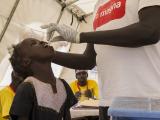Sep 8, 2008 (CIDRAP News) – At the request of a meat industry group, the US Department of Agriculture (USDA) is considering allowing the low-dose irradiation of beef carcasses to kill pathogenic bacteria on the surface.
The USDA already permits irradiation of raw meat to reduce pathogens, with a requirement that the treated products be clearly labeled as irradiated. The proposal now under consideration would classify low-dose irradiation of carcasses as a "processing aid," meaning that products made from the carcasses would not have to be labeled as irradiated, according to a Federal Register notice dated today.
The USDA's Food Safety and Inspection Service (FSIS) has scheduled a hearing on the proposal for Sep 18 in Washington, DC, scheduled to run from 9 a.m. to 1 p.m. at the L'Enfant Plaza Hotel, 480 L'Enfant Plaza SW.
The FSIS announcement comes less than 3 weeks after the Food and Drug Administration (FDA) approved the irradiation of fresh spinach and iceberg lettuce, which were tied to Escherichia coli O157:H7 outbreaks that involved hundreds of illnesses in the fall of 2006.
The American Meat Institute (AMI) submitted a petition in July 2005 to allow low-dose, low-penetration, electron-beam irradiation of chilled beef carcasses, according to the FSIS notice. "The petition requested that information concerning irradiation treatment not be required on the label of any products derived from the carcass," it states.
The AMI argues that low-dose, low-penetration irradiation is a processing aid because the electron beam reduces pathogens on the carcass surface without affecting the flavor, nutritional quality, appearance, or shelf life of meat from the carcass. The radiation dose proposed is 1 kiloGray (kGy) or less (compared with up to 4.5 kGy for irradiation of meat products such as ground beef), and the beam would penetrate no more than 20 millimeters into the meat.
The FSIS has allowed irradiation of raw meat and meat byproducts to reduce contamination since 1999, but the process has not been widely used. Irradiated products must carry a logo called the radura plus the phrase "treated with radiation" or "treated by irradiation."
The AMI fortified its petition with evidence from several studies, according to the FSIS. For example, a USDA study showed that pieces of carcass inoculated with high doses of E coli O157:H7 and then treated with low-dose irradiation had no detectable E coli 48 hours later.
Another USDA study found that low-dose irradiation had no effects on the aroma, tenderness, or flavor intensity of flank stank, according to the FSIS notice. The treatment affected the redness of the meat, but the effect was considered slight and unlikely to affect consumer acceptance.
The FDA has tentatively said it would not object to treating low-dose, low-penetration irradiation of beef carcasses as a processing aid, FSIS reported.
The FSIS said it has tentatively concluded that the AMI proposal has merit. But the agency is seeking comments on whether:
- there is evidence contradicting the findings presented by the AMI
- there is evidence suggesting that the FSIS should consider the cumulative effects of irradiation of beef carcasses and any subsequent radiation dose, such as the dose from irradiation of ground beef
- there are factors the agency has not considered
The agency has set a deadline of Oct 18 for commenting on the proposal. (See the Federal Register link below for information on how to submit comments.)
See also:
USDA Federal Register notice
http://www.fsis.usda.gov/Frame/FrameRedirect.asp?main=http://www.fsis.usda.gov/OPPDE/rdad/FRPubs/2008-0028.htm
Aug 21 CIDRAP News story "FDA approves irradiation of iceberg lettuce, spinach"
Centers for Disease Control and Prevention information on food irradiation
http://www.cdc.gov/nczved/divisions/dfbmd/diseases/irradiation_food/
FDA information on food irradiation
http://www.fda.gov/Food/ResourcesForYou/Consumers/ucm261680.htm


















